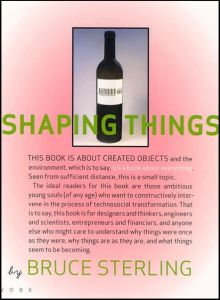Join getAbstract to access the summary!

Join getAbstract to access the summary!
Bruce Sterling
Shaping Things
MIT Press, 2005
What's inside?
How the nascent "Internet of things" will change the world.
Recommendation
Type a few words into Google and you can find a sushi restaurant, a movie theater, concert tickets or a new car. But if you misplace your car keys in your house, you still have to search the old-fashioned way: room by room, cushion by cushion, coat pocket by coat pocket. If Bruce Sterling is correct, though, one day you'll Google your keys. And your shoes. And your dog. This is the nascent "Internet of things" made possible by technology, including such items as radio frequency ID tags and traceable product life cycle management. That is where technology is going: to the interactive "spime," Sterling's term for objects that will arrive with data attached. In this visually arresting novella-sized essay, Sterling riffs on a number of scenarios, from customized-to-order cell phones to products that "know" how much carbon their construction required. His aphoristic prose seems at times like madness, but there's method in it: Sterling urges designers to make beautifully sustainable products rather than more proto-trash. getAbstract believes his book could reform your ideas about design and provide a stock of carbon-neutral insights you can deliver to your colleagues over a recyclable cup filled with shade-grown coffee.
Summary
About the Author
Bruce Sterling is a science fiction author and journalist. He was "visionary in residence" at the Art Center College of Design in Pasadena, California.
















Comment on this summary